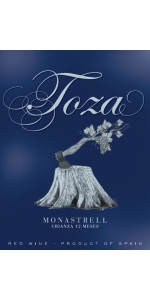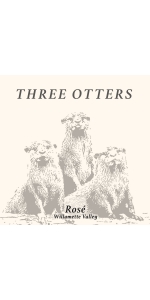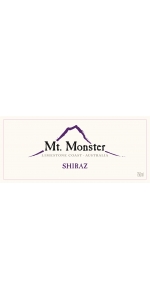Riebeek Shiraz 2021
12 bottles with free shipping for: $180.00
| BUY MORE! SAVE MORE! | ||||||||||||||||
|
| Country: | South Africa |
| Region: | Riebeek Kasteel |
| Winery: | Riebeek Cellars |
| Grape Type: | Shiraz |
| Vintage: | 2021 |
| Bottle Size: | 750 ml |
Riebeek Cellars Shiraz is made from 100% Shiraz.
Cold soaked for one day and then inoculated with selected yeast. Fermentation temperature was between 24 - 26 degree Celsius. Malolactic fermentation was done with French oak chips and American oak staves. This
was then blended with wine matured in 2nd and 3rd fill barrels for 12 months.
Often referred to as Shiraz Country, the Riebeek Valley is renowned for exceptional Shiraz wines. The Riebeek Shiraz is a lively rich wine, full bodied with a subdued smokiness on the nose and a pallet of ripe fruit and
interesting spice. Well-balanced and smooth, the aftertaste lingers with the exciting flavors of Christmas pudding.
Serve at room temperature. The perfect companion to barbequed lamb, filet medallions and game. Lovely with Springbok stuffed with bacon, garlic and rosemary and a great match to a cheese and preserves platter.
The Riebeek Cellars Estate
Riebeek Cellars was established in 1941 and is situated in Riebeek Kasteel at the foot of Bothma's Kloof Pass. This medium-sized winery on the western coast of the Cape Province of South Africa sources its grapes from the fertile Riebeek Valley and the slopes of the mountain where the climate is very similar to the Mediterranean. Through the years as vineyard practices developed, cultivars were planted in soil and at slopes best suited to them. These well-tended vineyards enable the production of high quality wines which makes Riebeek Cellars the choice of wine buyers internationally. Well-known both in South Africa and abroad, Riebeek Cellars manages a variety of brands for various countries.
Heritage
Corporal Pieter Cruythoff, a scout of Jan van Riebeeck, founded the Riebeek Valley in 1661. Impressed by the single standing mountain, he called it Kasteelberg (“Castle Mountain”) commemorating the Castle of Good Hope in Cape Town, the fortress of Commander Jan van Riebeeck. The twin towns, Riebeek Kasteel and Riebeek West, established at the foot of Kasteelberg, are therefore also suitably named after Van Riebeeck.
The Riebeek Valley is a mecca of wonderful wines, exceptional food and exquisite art where tourists and locals alike are forever tempted into spending more time than allowed. The serene valley falls in the bigger Swartland region which is called the 'bread basket' of South Africa for its grain production, while it is further internationally acclaimed for its high quality olive products. With various hotels and fine-dining restaurants as well as true country hospitality, the Riebeek Valley has become a very popular tourist destination. The ultimate charm of Riebeek is however in its people and their commitment and passion for wine.
"Located in the Western Cape region of South Africa, this winery was established in 1941, which makes it relatively old compared to all the new wineries that have sprung up in this area. Among the first Pinotages I can recommend, it’s also a good value. Pinotage, which is, of course, ubiquitous in South Africa, was first made in 1941, when the Cinsault grape (primarily grown in southern France and the Rhone Valley) was crossed with Pinot Noir." - Robert Parker's Wine Advocate (Issue 201, June 2012).
Toza Crianza Jumilla is made from 100% Monastrell (Mourvedre). Toza Crianza is a classic example of the Monastrell variety from the Mediterranean region, made from hand harvested old vines and aged 12 months in oak barrels. This Spanish red is rich, toasty, round and velvety.
Review:
Review:
"Opaque ruby. Dark berries, coconut and a hint of spiciness on the powerfully scented nose. In a round and generous style, showing very good depth and appealing sweetness to the blackberry and cherry cola flavors. Soft, even tannins add gentle grip to a long, smooth finish that leaves hints of vanilla and dark fruits behind. Raised in a combination of French and American oak barrels. - Josh Raynolds"
- Antonio Galloni's Vinous (March 2021), 90 pts
Fullerton Three Otters Rose is made from 60% Pinot Noir, 40% Pinot Gris (7-50 years old)
This Willamee Valley blend hails mainly from three different vineyards in the north, east, and south of the Willamee Valley, with a smaering from five of our other sites. The soils of the vineyards represent the breadth and diversity of the Willamee Valley with both sedimentary- and volcanic-based soils.A nose of fresh strawberries, watermelon rind, and lemon blossom with the palate echoing these flavors along with green apple and lemon. Cool climate vibrancy melds with lovely texture. Great tension and energy.
Acid: TA 5.6 g/L
pH: 3.45
Aging: 100% stainless steel
Bottled Unfined
Clones: Pommard, Wadensville, Dijon 113, 114, 115, 667, and 777
The story of Fullerton’s rosé originates from the 2012 harvest. Winemaker Alex Fullerton and his father and proprietor Eric Fullerton couldn’t decide on a house style for rosé, so they held a friendly competition. They each made a rosé to see whose would win over a crowd. Though the wines were destined to be boled separately, Alex got curious and tried blending the two. Voila! The sum was better than the parts, and a tradition was born. Alex now makes one rosé that is whole cluster pressed and tank fermented, yielding a very crisp and light colored wine, while Eric crafts his rosé from a more robust extraction, which yields a darker and fuller-bodied wine. The two lots are then blended to taste, delivering a crisp, fresh rosé with wonderful structure. The juice spent three weeks on the gross lees prior to fermentation to extract aroma precursers, and then six months on lees post-fermentation.
Pairs with soft cheeses, chicken/turkey.
Bright and glossy ruby red in color. On the nose it reveals aromas of small fresh berries and a trace of sour cherry, melded with hints of blackberries and black cherries, followed by a hint of vanilla. A fragrant wine with satisfying intensity. On the palate it is warm, smooth and a medium-bodied with finely-balanced tannins. Dry and sinewy yet fresh with a persistent, aromatic finish.
It naturally accompanies dishes that are typical of Tuscan cuisine with its bold, authentic flavors, such as pasta and risottos made with mushrooms or truffles, pork, grilled meats and medium-matured cheeses.
Review:
Notes of ripe cherries, dried flowers and walnuts with hints of anisette and licorice. Medium- to full-bodied, compact and dense with creamy tannins and steady acidity. Weighty and structured. Drink or hold.
-James Suckling 91 Points
The Kasteelberg range of wines, celebrates the discovery of Riebeek and the Kasteelberg mountains in 1661. Kasteelberg stands sentinel over the fertile valley below. From the slopes of the mountains, hand-selected grapes are expertly crafted with care to produce rare and expressive wines. The Kasteelberg range truly is the pinnacle of our Winemaker's art.
Often referred to as Shiraz Country, the Riebeek Valley is renowned for exceptional Shiraz wines.
The Kasteelberg Shiraz is a lively rich wine, full bodied with a subdued smokiness on the nose and a pallet of ripe fruit and interesting spice.
Well-balanced and smooth, the aftertaste lingers with the exciting flavors of Christmas pudding.
Serve at room temperature. The perfect companion to barbequed lamb, fillet medallions and game. Lovely with Springbok stuffed with bacon, garlic and rosemary and a great match to a cheese and preserve platter.
Review:
"I'd expect to prefer the 2017 Shiraz to the 2018 bottling, but it's actually the reverse. Maybe Alecia Boshoff has just got more experience with the fruit from this Kasteelberg site. Sweet and spicy, with enticing incense and violet aromas, fine tannins, succulent red berry fruit and deftly integrated one-third new oak. 2021-26"
- Tim Atkin (South Africa 2020 Report), 92 pts
The Kasteelberg range of wines, celebrates the discovery of Riebeek and the Kasteelberg mountains in 1661. Kasteelberg stands sentinel over the fertile valley below. From the slopes of the mountains, hand-selected grapes are expertly crafted with care to produce rare and expressive wines. The Kasteelberg range truly is the pinnacle of our Winemaker's art.
Often referred to as Shiraz Country, the Riebeek Valley is renowned for exceptional Shiraz wines.
The Kasteelberg Shiraz is a lively rich wine, full bodied with a subdued smokiness on the nose and a pallet of ripe fruit and interesting spice.
Well-balanced and smooth, the aftertaste lingers with the exciting flavors of Christmas pudding.
Serve at room temperature. The perfect companion to barbequed lamb, fillet medallions and game. Lovely with Springbok stuffed with bacon, garlic and rosemary and a great match to a cheese and preserve platter.
Review:
"I'd expect to prefer the 2017 Shiraz to the 2018 bottling, but it's actually the reverse. Maybe Alecia Boshoff has just got more experience with the fruit from this Kasteelberg site. Sweet and spicy, with enticing incense and violet aromas, fine tannins, succulent red berry fruit and deftly integrated one-third new oak. 2021-26"
- Tim Atkin (South Africa 2020 Report), 92 pts
Riebeek Cabernet Sauvignon is made from 85% Cabernet Sauvignon,15 % Shiraz.
An exciting new world style wine with upfront blackcurrant flavors. The black fruit is well-balanced with subtle French oak for a complex nose and an elegant and lingering follow-through. An exceptional example of a lighter style Cabernet Sauvignon that can be enjoyed young. Excellent with red meat dishes or veal.
Mollydooker Velvet Glove Shiraz is made from 100 percent Shiraz.
Sticky plum jam and spicy nutmeg aromas are alluringly prominent on the nose, whilst berries and mocha weave
and envelop your entire palate. The finish is incredibly smooth and silky, with elegant fruit flavors that linger in your mouth. An outstanding example of a perfectly balanced Shiraz from McLaren Vale.
Mt Monster Shiraz is 100 percent Shiraz
Deep purple in color. Ripe cassis and black plum fruits on the nose with violets. Varietal fruit-driven palate, with cassis and dark berryfruit and spice flavors. Soft tannins compliment the fruit with mouth-filling generous finish.
French & American oak has been used sparingly to ensure maximum fruit expression is retained in the final wine.
Our Shiraz is fermented in static fermenters at controlled temperatures to retain the varietal aromatics. Once complete the wine is left for 7–10 days on skins to aide in the extraction of soft fleshy tannins and build wine structure.
- back
“1752” is the name of the Damilano Barolo Cannubi Riserva, in honor of the year in which the historic bottle was first marked “Cannubi”. It still exists today perfectly conserved by the Manzone family in Bra, close to Barolo. The bottle is clearly marked as being of “1752” vintage, indicating that Cannubi historically precedes Barolo.
About the Vineyard:
The Cannubi Cru is in found within one of the 6 core zones which comprise a UNESCO heritage site in Italy. A mixture of Tortonian and Helvetian calcareous marl gives the grapes intense aromas of cherry, plum and tobacco, rose and violet in sequence. Its low potassium and high calcium/magnesium content offer the wine a fine and polished touch. The vineyard is located at about 270 m. a.s.l. and has a south-east sun exposure. Barolo Riserva Cannubi 1752 It is a small plot of about 2 hectares of Nebbiolo vines, currently between 30 and 50 years of age.
Tasting Notes:
Garnet ruby red in color, the bouquet is intense and balanced, with notes of violet, red fruit, cherry and plum, spices, liquorice, cocoa, leather and tobacco. Dry, robust, full-bodied, very persistent, rich and velvety
Food Pairing:
This wine is excellent with typical piedmontes pasta (tajarin, ravioli); perfect with red meat, braised and roast meat, game and absolutely ideal with all types of cheeses.
Review:
The purity of this wine is pretty phenomenal with blackberries, strawberries, fresh flowers and licorice. Hints of tar. It’s full-bodied, yet composed and compact with ultra fine tannins and a long, flavorful finish. Very structured. Try after 2024.
-James Suckling 97 Points
Jonive Chardonnay Russian River Valley is made from 100 percent Chardonnay.
2021 Jonive Russian River Estate Chardonnay: Harvested the night of September 20th with the two clones kept separate. The clone 95 was pressed into tank where it was chilled, settled and racked, then allowed to ferment naturally for 12 days when it then went to barrel. The primary and secondary fermentations lasted in barrel until April 20th, some seven months. The wine remained on its original lees until just prior to bottling. The clone 17/Robert Young chardonnay was pressed into tank and allowed to brown naturally before a natural fermentation occurred. This lasted for 15 days before going to barrel where it finished the last 12 days of primary fermentation and six weeks of secondary fermentation and it too rested on its original lees until just prior to bottling.
The wine has a typical straw color and complex aromas of lemongrass, nutmeg, Meyer lemon and a touch of passionfruit. It has an enveloping mouthfeel that is at once tart and linear as well as rich and expansive, a very unusual and beguiling combination of textures and mouthfeel. The browning of the clone 17 enables the wine to be rich, but at a lower alcohol (13.3%) and the clone 95 contributes beautifully fresh acidity. The pallet shows jasmine, honeydew melon, tarragon and lemongrass with a nice kiss of high-quality French oak. The extended lees contact gives the wine amazing length, energy and vitality.
353 cases produced
Harvested September 20th
14-month barrel aging in 67% new French oak barrels, 20% once used and 13% neutral
61% clone 17/Robert Young and 39% clone 95
13.3% alcohol
Bottled December 14th
Reviews:
A wildly elegant aromatic profile announces this Chardonnay from Jonive's estate vineyards, a combination of two separately fermented clones, 95 and clone 17, also known as Robert Young. The blend is beautiful and effusively aromatic. Lemon cream and white flowers mark the aromatic profile, and the palate, crafted with plenty of lees contact, shows a creamy texture of lemon and orange oils. Savoury notes of sorrel and lemongrass mark the lengthy finish. The new French oak kisses this wine just a touch with a note of Madagascar vanilla on the finish.
-Decanter 94 Points
This seamless, smooth and mouthfilling wine is packed with ripe fruit flavors and deftly accented with oak notes like vanilla, hazelnut and toast. It's rich in texture yet relatively light in body, encouraging flavors that mingle with a subtlety that asks for more sipping.
-Wine Enthusiast 94 Points













